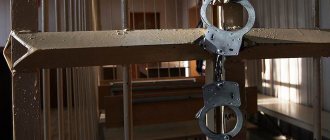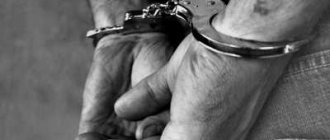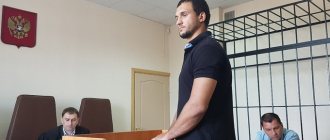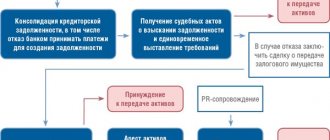In Kemerovo, two friends put the body of their acquaintance in a closet, took it out of town and set it on fire in a ditch near the road. The charred remains were accidentally discovered by one of the drivers passing by. As investigators found out, one of the friends stabbed 28-year-old Sergei Panin with a knife during an argument. The second only helped to hide and destroy the body. The killer was tried under Article 105 and sentenced to 11.5 years in prison. His assistant friend was found guilty of concealing a crime, but got off with a fine - the court ordered him to pay 190 thousand rubles.
Punishment for “concealment of especially serious crimes not promised in advance” is provided for in Article 316 of the Criminal Code. It may result in a fine, forced labor, arrest or imprisonment. The maximum term is two years in prison.
In practice, those who help murderers get rid of a corpse are most often convicted of concealment, but the article also provides for liability for assistance in getting rid of traces of a crime, documents, cars (or providing a car for transporting weapons or a corpse), as well as murder weapons or other especially serious crime.
Thus, in Chelyabinsk, in the spring of 2021, charges under Article 316 were brought against Elena Samsonova and Semyon Labetsky, friends of Edward Krause, who organized the murder of his friend. Born Eduard Shutkin (he changed all his documents to a new name shortly before the crime), according to investigators, he killed his girlfriend with several shots to the head; The woman left behind three small children. Samsonova and Labetsky helped Krause get rid of the corpse, after which the woman gave him a ride to the airport and thus helped him escape, and the man drove the alleged killer’s SUV into the garage.
A 17-year-old teenager from Petropavlovsk-Kamchatsky asked his brother and a friend (both adults) to help bury the body of the man he killed. The young people did not refuse. The criminal was quickly found, and a year after the murder, in 2014, he was sentenced to seven years in prison. The accused spoke not only about his role, but also about the service provided by a relative and acquaintance, and in the summer of 2016 a case was opened against the latter for concealing a murder. The brother of the convicted person does not face liability: “A person is not subject to criminal liability for concealment of a crime committed by his spouse or close relative that was not promised in advance,” says the note to Article 316.
"False sense of camaraderie" and suspended sentences
Every year in Russia, courts pass about 300 sentences under Article 316: in 2015, 238 people were convicted, in 2014 - 254 people, in 2013 - 238, in 2012 - 269, in 2011 - 297, in 2010 - 348, in 2009 - 402 people .
The most frequently used punishment is a fine, usually no more than 100 thousand rubles. In December 2021, a 20-year-old resident of the village of Shulgino, located near Perm, was sentenced to a fine. In May 2021, he saw how his friend stabbed a man on a neighboring property and dragged the body into the house. As stated in the verdict, “out of a false sense of camaraderie,” the 20-year-old Perm resident not only did not report the murder to the police, but helped his friend hide the body and remove traces of blood. It is not specified how much the court fined him for concealment.
But it is known that the court imposed a fine of 50 thousand rubles on 48-year-old Vladimir Pachin from Tver, but exempted him from paying it due to the amnesty. True, Pachin will still have to pay 270 thousand rubles to the family of 15-year-old Daria S., whose corpse he carried out of the apartment where the girl was raped and killed, and then taken to the forest in the Staritsky district of the Tver region. The rapist, Alexander Treshchatov, who abused a teenage girl and stabbed her to death, hanged himself in a detention center, and his accomplice, 36-year-old Svetlana Sbrueva, received 15 years in prison in the summer of 2021. Among the articles charged against Sbrueva was Article 316, but the accusation did not stop there: the woman not only cleaned the apartment and hid the girl’s things after her death. While Treshchatov raped her, Sbrueva helped hold the victim and threatened her with a pistol.
Svetlana’s case is typical: as a rule, those accused under Article 316 receive actual prison terms for several crimes. In the summer of 2015, a young resident of the city of Minusinsk, Krasnoyarsk Territory, asked her friend to go home with her: the woman was afraid that her boyfriend might beat her, and in front of the guest, she believed, he would behave decently. The friend was not alone, but with her three-year-old daughter - all three of them came to the apartment, where the 26-year-old lover of the owner of the house was already waiting.
Contrary to the women’s hopes, he did not hold back in front of strangers, and when a friend intervened in the conflict, he stabbed her several times and killed her. But the man did not stop there: with shouts and threats he demanded that his mistress cover up the traces of blood, grabbed a three-year-old girl and threatened to kill all the survivors. While in the apartment, the killer called his 24-year-old friend, who arrived in a car, into which the accomplices pushed a sobbing child and the corpse of his mother and drove to neighboring Khakassia. A woman who had locked herself in the apartment called the police, but they could not save the girl: the killer stabbed her to death in a country house near Abakan, where she and a friend brought the body, after which he left both bodies in the house and set it on fire. The accomplices were detained the next morning. For the brutal double murder and kidnapping of a child, the 26-year-old defendant was sentenced to life imprisonment in May 2021, and his friend was sentenced to six years in a maximum security colony and a fine of 100 thousand rubles for complicity in the kidnapping and concealment.
An 18-year-old accomplice to another brutal crime - the murder of a 10-year-old child in the city of Lysva, Perm Territory - although she was charged in addition to Article 316 under Article 117 (torture of a minor), received six years probation. The boy's older sister helped his father, who had beaten the child to death with a wooden board, take the body to the ice hole and drown him, tying a weight to his feet. As it turned out during the investigation, the boy was beaten and raped by his father (more than 30 episodes of crimes), his mother and older sister were constantly beaten, in addition, the child was locked in a cold basement and was not allowed to eat. The father received a life sentence, the mother received five years in prison with a suspended sentence until 2029: the woman who abused her middle son also has a younger one-year-old child.
Of the 238 people convicted in 2015 under the article “Concealment,” 26 people, like the 18-year-old resident of Lysva, received suspended sentences, 38 received real sentences. Among them, for example, is a 47-year-old resident of the city of Kholmsk on Sakhalin Island, who helped a friend take out and put in trash cans the dismembered remains of a man he had killed. He was given six months in a colony-settlement.
81 people were sentenced to fines, one to forced labor, another six were found guilty, but for various reasons were released from responsibility. 86 people were amnestied in connection with the 70th anniversary of the victory in the Great Patriotic War.
A corpse in the carpet under the noses of the police and other stories
Full statistics from the Judicial Department at the Supreme Court for 2016 are not yet available, but it is already known that in the first six months of 2016, courts handed down 108 sentences under Article 316. 15 people received real sentences (14 of them - less than one year), 13 - suspended imprisonment, 44 people - fines, two people - another suspended sentence. 27 people were released from punishment under an amnesty, and seven more on other grounds.
In September 2021, the Leninsky District Court of Omsk ordered 25-year-old Ruslan Leshko and 21-year-old Vladislav Veshnyakov to pay a fine of 10 thousand rubles each. On the night of February 25, 2021, the young people received a call from their 20-year-old friend, who asked them to urgently come to his home. On the spot, it turned out that the owner of the house, along with two other friends, beat his mother’s partner to death. Veshnyakov and Leshko agreed to help bury the body in a grove not far from the house and carried it out of the entrance in a carpet. But there were policemen standing on the corner, and upon noticing them, the young people threw the body right next to the house and ran away. The police did not pay attention to the carpet: the deceased was found a day later by passers-by. Three accused of his murder received nine years in a maximum security colony.
Among those still awaiting trial is Kristina Chistyakova, an accomplice of those accused of attacking the family of the head of the Department of Internal Affairs of the city of Otradny, Samara Region. Her acquaintances beat policeman Dmitry Vashurkin and killed his wife, after which they robbed their house and fled. Chistyakova is accused of helping to hide stolen money, bank cards and other valuables.
In the Kaluga region, they continue to investigate the murder of a four-year-old girl in a foster family: the woman who adopted her beat the child to death with a mop. The husband of the accused murderer was charged with Article 316 because he helped take the girl’s body to the forest and bury it there. In total, there were three children in the family: the couple’s own 11-year-old son and the 16-year-old brother of the deceased girl are now in a boarding school.
In Irkutsk, the investigation into the murder of a prostitute has been completed: her 23-year-old colleague strangled her out of jealousy. The boyfriend, who cheated on one sex worker with another, helped get rid of the corpse after the murder: he dismembered it and buried it, and his girlfriend fled to Kamchatka. Six months later, the police found the murder suspect and arrested her; the accomplice, accused under Article 316, is under recognizance not to leave the place.
Ways to conceal murders and their traces
Depending on the conditions of the crime scene, the perpetrators resort to various actions in order to conceal the murders and their traces. With all the variety of ways to hide traces of murders, two main types can be distinguished: concealing the fact of a murder and staging.
The criminal resorts to concealing the fact of murder in cases where he does not have the opportunity to stage a suicide, an accident, or when he believes that he cannot convincingly justify the reason for meeting the victim in a certain place. In such situations, the killer, by concealing the fact of the crime, attempts to avoid explanations regarding the circumstances of the victim’s death and tries to avert suspicion of causing it.
The main goals that the killer pursues when committing actions to conceal the murder are as follows. This:
- concealment of the fact of violent death of the victim;
- destroying traces of one's involvement in the murder;
- creating a false situation allowing one to suspect another person of committing a crime;
- creating conditions that make it difficult to identify the victim;
- concealment or destruction of the murder weapon;
- disguising the true motives for the murder;
- staging careless death, accident, suicide, natural death.
In such cases, criminals often bury the corpse and throw it into water bodies. Often, a corpse is dismembered, and its parts are hidden in different places unnoticed by others; disfigure the face, destroy documents, clothes and personal belongings of the victim, or even destroy the corpse by burning it at the crime scene or in another place. As a rule, such methods of concealing a murder are resorted to by criminals who were in close relationships with the victim, his relatives, as well as persons into whose home the victims ended up by accident or were lured there on purpose.
Staging is the creation at the scene of an incident by an interested person or persons of a situation that does not correspond to the event that actually occurred at that place. As a method of concealing a murder, staging is used to evade responsibility, most often by members of the victim’s family, his relatives, acquaintances, whose relationships and connections with the victim are well known to others.
Staging a suicide, accident, natural death, or the commission of a crime by another person or in another place often involves:
- in changing the situation at the scene of the murder;
- destruction or falsification of traces of hands, feet, bodily injuries, etc.
- spreading false rumors about the victim’s departure to another place or the circumstances of his disappearance, etc.
Various circumstances can serve as signs of a staged suicide, accident, or natural death:
- the impossibility of the victim committing the actions referred to by the perpetrator or witnesses;
- the presence of signs of struggle at the scene of the incident, self-defense - on the victim’s clothes and corpse;
- changing the situation at the scene or destroying traces;
- contradictions in the explanations of interested parties regarding the behavior of the victim and the causes of his death;
- inconsistency between the posture of the corpse and damage to clothing and body, etc.;
- other circumstances.
Signs of a staged suicide include the absence of reasons for suicide, the discovery of a fabricated “suicide” note, the absence of instruments that could have caused death, etc.
Staging, like any other type of human behavior, is reflected on material objects of animate and inanimate nature, in the memory of people - participants and eyewitnesses of the staging, and other persons who have otherwise acquired the relevant information. In this regard, information about the staging can be obtained as a result of an investigation of the scene of the incident, objects found there, as well as on the basis of operational investigative work with people who are carriers of the sought information.
When examining the scene of the incident, the following signs of staging are revealed:
- traces found at the scene of the incident that should not remain if the event under study were real and not imaginary (traces of presence);
- traces that were not discovered due to their absence, but which certainly should have appeared in the event of the reality of the staged event (traces of absence);
- The traces found at the scene of the incident are among the traces characteristic of the staged event, but their condition does not correspond to the one in which they should be in the current situation (in appearance, quality, quantity, etc.).
In particular, murders are often veiled by creating the appearance of death due to negligence, for example, as a result of the victim falling from a height. Signs that can help expose a staging include the following:
- an excessively large distance between the corpse and the outer part of the object (the outer wall of the building) from which the deceased allegedly fell;
- inconsistency between the version of an accidental fall from a height and the nature of the injuries on the corpse;
- the presence of signs of a struggle or struggle at the site of the object from which the victim allegedly fell;
- testimony of any persons casting doubt on the version of the accident.
In the case of staging a death as a result of careless handling of a firearm, signs of staging may include circumstances such as the impossibility of firing a shot from a weapon found near the corpse; the impossibility of a spontaneous shot, the discrepancy between the traces of a shot on the corpse and the traces that are real - in case of careless handling of a weapon.
The following circumstances may contribute to solving a murder with the use of firearms staged as a suicide:
- the absence of a weapon at the scene or its presence in a place where it could not have been during a suicide;
- no signs of a shot at close range on the corpse;
- the physical impossibility of the deceased to inflict a gunshot wound on himself in the part of the body where it was found;
- establishing that the bullet found in the body of the corpse was not fired from the weapon that was at the scene of the incident.
Signs pointing to a murder disguised as self-hanging have long been known. Among them are the following:
- the presence on the corpse of traces of manual strangulation (linear or crescent-shaped abrasions, round bruises on the victim’s neck from the fingers of the strangler);
- detection of abrasions, bruises around the victim’s nose and mouth, and other marks indicating that death occurred from the closure of the respiratory openings;
- the presence of a closed, horizontal groove on the neck of the corpse, etc.
Traces of staging at the scene of an incident, indicating this event, arise against the will and desire of the stager, on the one hand, due to the excitement, haste of the criminal under conditions of time shortage, lack of necessary skills, etc. On the other hand, trying to present the event in a favorable light , acting calmly, skillfully, prudently, the criminal makes every effort to optimally achieve the goal, but at the same time loses his sense of proportion and sense of reality itself. In such cases, the killer can leave an excessively large number of traces of the simulated event, give them a pronounced character, a catchy appearance, which ultimately can play the opposite role - cause the investigator to doubt the reality of the event.
Signs indicating the possibility of staging an event can be the subsequent (after staging) actions of the stagers, various kinds of inadequate situations that make it possible to doubt the truth of what was found at the scene of the incident, the veracity of the explanations of what happened. They can be involuntary slips of the tongue during interrogation, flaunting the fact of one’s participation in the staging in the process of informal communication with outsiders, in a heart-to-heart conversation with one’s friends, establishing the fact of the sale of any things that allegedly disappeared during the staged event, etc.
Since, as part of the consideration of the issue of methods of concealing murders, special attention was focused on the signs of staging, it is advisable to analyze the essence and mechanism of their identification and exposure.
The information base for exposing the staging is formed by data that can be collected:
- when examining the situation at the scene of the incident and identifying signs indicating the possibility of staging;
- as a result of the exposure of perjury by persons uninterested in establishing the truth;
- by checking the convincing arguments of the relatives of the person who allegedly committed suicide, who categorically deny the very possibility of the event, etc.
The essence and mechanism for identifying and exposing the staging is as follows.
Let us assume that some criminal event took place, in connection with which corresponding traces arose in the surrounding environment of the crime scene. The participant in this event builds a mental model of another event that is possible in this situation, and is engaged in its implementation at the scene of the incident by making changes to the situation, giving it a form that, in the opinion of the stager, would correspond to the simulated event. However, the mental model and the results of its materialization cannot coincide in all respects. Therefore, not all features of the model, for objective reasons, can be adjusted to the features of an imaginary event, and all features of a real event can be destroyed or completely changed. In this regard, the possibility of perceiving a real event through the prism of staging is created. This possibility, as a result of the detection and actualization of signs characteristic of the hidden event and unusual for the simulated, imaginary event, evolves into reality.
To achieve the goals of identifying and exposing the staging, the research subject carries out:
- building a mental model of an event, the signs of which are clearly presented in the setting of the scene of the incident and seem to lie on its surface, imposing the idea that it happened exactly this way and not otherwise;
- building typical competing mental models of other events possible in a given situation;
- studying the constructed models and deriving consequences from them, their subsequent verification;
- establishing the reality of some consequences and the unreality of others;
- comparative analysis of models not excluded from verification and detected traces, formulation of a thesis about the adequacy of any model to the original, i.e. an event that actually took place;
- obtaining additional data that objectively confirms the reality of this model and eliminates the possibility of error;
- making a decision to complete the event recognition process with all the ensuing legal consequences.
The implementation of the proposed scheme is carried out by re-inspecting the scene of the incident; interrogation of persons who discovered the event under investigation, as well as persons related to the scene of the incident on a domestic, official, or other basis; studying medical and other documents of victims; expert research of all kinds of objects.
Depending on the nature of the crimes against life, the methods of their commission and the murder weapons used, traces of various origins and other material evidence remain at the scene. The most common ones include the victim’s corpse, damage and changes on it, the condition of clothing, blood stains, traces of feet, fingers, food remains, etc. Often, if they are identified, properly recorded and included in the materials of the criminal case, they form the main working material used in the investigation process, and have enormous evidentiary value due to the fact that in most criminal cases of murder there are no eyewitnesses. That is why the main attention in the process of proving the event of a crime and the guilt of a particular person in committing a murder should be focused on the study of both physical evidence and other evidence established in the process of investigative actions.
Taking into account the fact that discovered and seized traces and other material evidence in murder cases quickly change, disappear, and can easily be damaged, the investigation process becomes significantly more complicated. In this regard, the primary task of the investigator is to promptly and efficiently carry out initial investigative actions aimed at detecting, recording and forensically examining the named objects, while simultaneously identifying and studying the causes of negative circumstances, establishing their connection with the event under investigation.
When characterizing crimes against life, one cannot leave out of sight the most important elements of murders that are important for the proper organization of their detection, such as the place and time of the crime. A study of the array of criminal cases of murder indicates that they are more often committed in the evening and at night.
If a murder is committed in an open area, then in most cases it occurs in darkened, uncrowded places. The place where a corpse is dismembered is almost always the home of either the criminal or the murder victim herself.
Establishing the exact time of the murder is necessary for the optimal organization of operational-search activities to identify and detain the criminal, check references to alibis, and in other cases.
The location of the murder makes it possible to determine the context of the crime event, identify and record traces indicating the mechanism of its commission, the tools used, the identity of the criminal and, at the same time, makes it possible to identify and record negative circumstances that reflect the side processes of interaction between its participants and objects accompanying the crime event or phenomena (absence of traces of blood under the corpse, presence of drag marks indicating its movement, a button found next to the corpse that does not belong to the victim’s clothing).
An important place in the context of characterizing murders is occupied by data on the personality of the criminal (information about his lifestyle, attitude to work, personal qualities, circle of acquaintances, connections and relationships with the victim, criminal record, etc.).
The personality of a killer is often characterized by selfishness, aggressiveness and cruelty, greed, vanity, everyday promiscuity, and disregard for other people’s interests, feelings, and public duty. Among them there are those who are characterized by willpower and cynicism. Others, on the contrary, are characterized by mental imbalance and a tendency to abuse alcohol and drugs. There are well-known facts of murders committed by persons with heightened suspicion and other mental abnormalities.
A separate group includes persons who committed murder when exceeding the limits of necessary defense or in a state of passion. Most of them do not possess the above-mentioned negative qualities and commit crimes due to an incorrect assessment of the current situation. Often such persons, after committing a murder, confess and actively repent.
Source – chapter from the textbook:
Cherechukna L.V. Murder investigation: Educational and methodological manual / Ministry of Internal Affairs of Ukraine, Lugan. state University extr. matters to them E.A. Didorenko. — Lugansk; RIO LGUVD im. E.A. Didorenko, 2009. -248 p. - Bibliography: pp. 237 - 247.
It would seem, what does Yarovaya have to do with it?
316 is not the only article of the Criminal Code that provides for liability for those who knew about the crime but did not report it to law enforcement agencies. In the summer of 2021, the State Duma adopted the so-called “Yarovaya package,” amending several laws and codes at once, including the Criminal Code. The goal proclaimed by the authors of the amendments, Deputy Irina Yarovaya and Senator Viktor Ozerov, is to tighten responsibility for crimes related to terrorism. In fact, the amendments oblige telecom operators and Internet providers to store and transfer to FSB authorities upon request information about calls and messages; equate social networks with the media; expand the list of crimes for which liability begins at the age of 14; prohibit missionary activity without registration; oblige Russian Post to check parcels for prohibited contents.
Among the amendments to the Criminal Code adopted in the “package” is Article 205.6 “Failure to report a crime.” Unlike concealment, the potential accused himself does not need to do anything under this article - it is enough not to report to the police or the FSB “about a person (persons) who, according to reliably known information, is preparing, committing or has committed at least one of the crimes provided for in Articles 205, 205.1 , 205.2, 205.3, 205.4, 205.5, 206, 208, 211, 220, 221, 277, 278, 279, 360 and 361.” Failure to inform becomes criminally punishable if a person knew about the preparation of terrorist attacks, hostage-taking, armed rebellion or an attempt on the life of a statesman. Punishment: up to a year in prison.
“I have not yet heard about the practice of applying this article, we will see in April in the statistics of the Judicial Department for the entire 2021. In general, non-reporting is the “non-reporting” that existed in Soviet criminal legislation, only named differently. Apparently, they wanted to find a wording without such a connotation, so that the word “denunciation” would not sound, but in fact it is the same thing,” lawyer Ivan Pavlov comments on the innovation. In his opinion, legislators in this case “invaded the plane of morality and morality”: “You find out that someone is preparing a terrorist attack, what will you do? The question is serious. Someone will immediately report, someone will try to stop, someone will pass by. A serious question - but not a legal one. And he was transferred to the field of law, and immediately criminal.”
The lawyer believes that Article 205.6 will first be applied in the North Caucasus, where many crimes of a terrorist nature are being investigated: “The article makes an exception for close relatives, they are not obliged by law to inform, but in the Caucasian republics family ties are stronger: uncles, cousins and grandchildren nephews are considered close relatives. There are entire villages where everyone is somehow related by family ties. Apparently, the article was introduced with the expectation that it would be possible to exploit it there, obliging everyone to inform on each other.”
“The key difference between Article 205.6 and Article 316 on concealment is that concealment is some kind of action: helping to hide traces, the consequences of a crime. The new article introduces punishment for inaction,” says Pavlov.
Ways to conceal crimes
There are a number of the most typical ways to conceal a crime.
1. Creating the appearance of one crime to hide another (staging).
2. Disguising a crime as a non-criminal event. For example, criminals, hiding theft, resort to destroying a low-value part of property, simulating a fire, flooding, etc. Murder is sometimes disguised as suicide or an accident.
3. Falsification of individual evidence. In an effort to direct the investigation along the wrong path, criminals deliberately leave “traces” of hands and feet, objects belonging to other persons, traces of blood, fibers of clothing, etc. At the same time, they try to give the “traces” a distinct expression and visibility, which contributes to exposing falsification.
Masking is the actions of a criminal or offender aimed at hiding the true intentions, misinforming and misleading law enforcement officers using special means and techniques to conceal involvement in criminal acts.
Detecting disguises
Often, a criminal, wanting to evade responsibility, seeks to prevent the establishment of the true circumstances of the unlawful act he committed through disguise.
A young woman told the police by phone that a robbery had been committed at her apartment. According to her, she trustingly opened the apartment door to an unfamiliar man and received a severe blow to the head. She lay unconscious for an hour and a half, and during this period of time the apartment was thoroughly robbed. After the investigative team arrived, the woman with a tear-stained face once again spoke about what had happened. Then she described the signs of the criminal and spoke in detail about the missing things. At the same time, she showed a bruise from the blow of the criminal, after which she lay unconscious for an hour and a half. The experience of the operatives suggested that such a bruise could not be caused by a strong blow, and perhaps the woman was involved in the crime. The additional work of the operatives made it possible to establish information that completely “collapsed” the version of the attack by an unfamiliar man on the apartment and its owner. The applicant herself sold the things of her sister, who worked abroad. Anticipating her imminent return, the criminal came up with a version of the robbery and, to disguise her participation, she struck her in the face, resulting in a small bruise.
Methods and means of camouflage include:
• masking the identity of the criminal (changing handwriting, appearance, voice, etc.);
• actions at the stage of preparation of a crime related to its concealment (making hiding places, preparing distribution channels for stolen goods, etc.) and disguising the role of the criminal (making false documents, purchasing police or military uniforms, etc.);
• disguising the connections of accomplices in the crime (use of special jargon, conventional signs, secret meetings, secret correspondence, etc.);
• actions to conceal traces of a crime (thoroughly wiping the table, door handles and other objects to destroy fingerprints, using special chemicals to treat shoe prints to throw off service dogs, imitating other people’s tracks - shoes, fingers, animal tracks, etc.). P.);
• development of methods for storing or destroying instruments and means of committing a crime and items obtained by criminal means.
Insufficient degree of credibility, discrepancies in the information conveyed by the criminal and the objective factors of the incident often lead to the revelation of disguises. The professional and psychological (especially communicative) preparedness of law enforcement officials plays an important role in exposing disguises. It allows them to determine insincerity and a tendency to present false information based on the smallest details in the behavior of suspected persons, contradictions in their statements, and nonverbal reactions. Staging - creating the appearance of an imaginary event by purposefully introducing changes into the situation of a real event aimed at disorienting the bodies of inquiry, preliminary investigation and court
Detecting staging
One of the types of disguises is staging. Typically, staging includes a system of camouflage actions to create an artificial picture of the incident in order to conceal the crime. By modifying the situation at the scene of the incident, the criminal aims to create among law enforcement officials and other persons an idea of the authenticity of the staged event, to disguise the true illegal act and to prevent the investigation of the crime and the prosecution of the perpetrators.
Staging, like any other type of human behavior, is reflected on material objects of animate and inanimate nature, in the memory of people - participants and eyewitnesses of the staging, and other persons who in one way or another have acquired the relevant information.
Therefore, information about the staging can be obtained as a result of studying the scene of the incident, the objects found there, as well as on the basis of operational investigative work with people who are carriers of the sought information.








